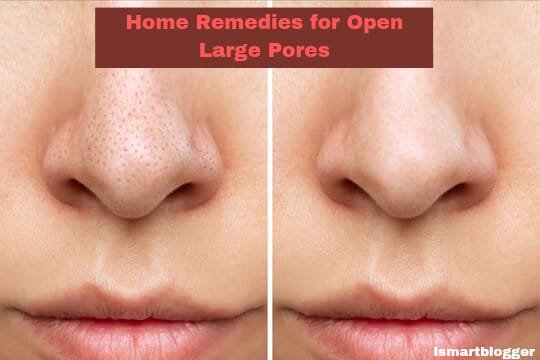Introduction
Welcome to this comprehensive guide on home remedies for open and large pores. In our quest for flawless and radiant skin, we often encounter the pesky problem of enlarged pores. The appearance of these enlarged pores can be quite distressing, as they not only affect our physical appearance but also contribute to various skin issues such as blackheads, whiteheads, and acne breakouts.
Definition and causes of open and large pores:
Open and large pores refer to the visible openings on the surface of our skin that allow sebum (natural oil produced by the sebaceous glands) to reach the skin’s surface. Pores appear larger when they are clogged with excess sebum, dead skin cells, dirt, or other impurities. While pore size is largely determined by genetics and age-related changes in collagen and elastin production, there are several factors that contribute to their enlargement.
Genetics: Unfortunately, some individuals are genetically predisposed to having larger pores. This is due to variations in their skin structure that result in larger openings.
Aging: As we age, our skin loses elasticity due to a decline in collagen and elastin production. This loss of elasticity causes the surrounding tissue around the pore openings to sag, making them appear larger.
Hormonal Changes: Hormonal fluctuations during puberty or pregnancy can stimulate increased sebum production. Excess sebum can accumulate within the pores, stretching them out over time.

Importance of treating open and large pores:
Treating open and large pores goes beyond mere cosmetic concerns—it is an essential step towards achieving healthy skin. Large pores can easily become clogged with dirt, bacteria, makeup residue, or environmental pollutants, leading to frequent breakouts and skin irritation.
Furthermore, if left untreated, these enlarged pores can also contribute to the formation of blackheads and whiteheads. Addressing open and large pores not only helps improve the appearance of your skin but also promotes overall skin health.
By adopting effective home remedies and incorporating a consistent skincare routine, you can minimize pore size, reduce the occurrence of acne breakouts, improve texture, and achieve a smoother complexion. Now that we understand the definition, causes, and importance of treating open and large pores let’s delve into the world of home remedies that can effectively tackle this common skincare issue.
Understanding the Skin
Structure and Function of the Skin
The skin, our largest organ, is a complex structure composed of three layers: the epidermis, dermis, and subcutaneous tissue. The outermost layer, the epidermis, acts as a protective barrier against environmental stressors. It consists of several sublayers, including the stratum corneum where dead skin cells accumulate and are shed.
Beneath the epidermis lies the dermis, which contains collagen and elastin fibers responsible for maintaining skin’s elasticity and strength. We have the subcutaneous tissue that provides insulation and cushioning to protect underlying structures.
The skin has numerous essential functions. Firstly, it serves as a physical barrier against harmful microorganisms by preventing their entry into our bodies.
Additionally, it regulates body temperature by sweating when we are overheated or constricting blood vessels in cold environments to conserve heat. The skin is also involved in sensation through nerve endings that allow us to feel touch, pain, heat, and cold.
Role of Pores in Maintaining Skin Health
Pores play a crucial role in maintaining overall skin health. These small openings on the surface of our skin are connected to hair follicles and sebaceous glands.
While pores are more visible on certain areas such as the nose or cheeks due to factors like genetics or oil production levels, they exist all over our bodies. The primary function of pores is to facilitate oil secretion from sebaceous glands onto the surface of our skin through hair follicles.
This natural oil called sebum helps keep our skin moisturized while providing some degree of antimicrobial protection against harmful bacteria. Furthermore, pores assist in regulating temperature by allowing sweat produced by sweat glands to reach the surface of your skin efficiently for evaporation.
This process aids in cooling down our bodies during physical activities or when exposed to warm environments. It is important to note that while pores are essential for maintaining skin health, their appearance can be a concern for many individuals.
Factors such as excessive oil production, dead skin cell buildup, or genetic predisposition can contribute to the appearance of open and large pores. Understanding how to care for our skin and minimize pore size becomes crucial in achieving healthy, radiant-looking skin.
Factors Contributing to Open and Large Pores
Genetics and Age-Related Changes
Open and large pores can be influenced by both genetic factors and age-related changes. Genetics play a significant role in determining the size of our pores, as some individuals are naturally predisposed to having larger pore sizes due to variations in their genes.
Additionally, as we age, our skin undergoes various changes that can impact pore size. One of the key factors at play is the production of collagen and elastin, proteins that provide structural support to the skin.
Influence of Collagen and Elastin Production
Collagen and elastin are crucial components responsible for maintaining the elasticity and firmness of our skin. Unfortunately, as we grow older, the production of these proteins starts to decline, leading to a loss of skin elasticity.
This reduction in collagen and elastin levels contributes to enlarged pores. With decreased support from these proteins, the walls surrounding our pores become less taut, causing them to stretch out and appear larger.
Effect of Hormonal Changes on Pore Size
Hormonal changes also play a significant role in pore size regulation. During puberty or times when there are hormonal imbalances such as during menstruation or pregnancy, an increase in oil production occurs due to elevated levels of hormones like testosterone.
This excess oil can clog the pores, making them appear larger. Furthermore, fluctuations in hormone levels can affect sebum composition, leading to thicker oil that is more likely to clog pores.
Environmental Factors
Sun Exposure and UV Damage
Excessive sun exposure is known to have detrimental effects on our skin’s health, including enlarging pores. When exposed to harmful ultraviolet (UV) rays from the sun, our skin’s natural defense mechanism is triggered, leading to an increase in melanin production.
This can result in thickening of the skin, obstructing the pores and making them appear larger. Moreover, repeated sun damage weakens the collagen and elastin fibers in the skin, compromising their ability to maintain pore structure and shape.
Pollution and Free Radicals
Living in urban environments exposes our skin to various pollutants such as dust, smoke, and chemicals present in the air. These pollutants can settle on our skin’s surface, clogging pores and causing inflammation.
Additionally, they generate harmful free radicals that damage collagen fibers and reduce elasticity. When the walls of our pores are compromised due to pollution-induced inflammation and oxidative stress caused by free radicals, they may become more visible.
Understanding these factors contributing to open and large pores allows us to develop effective home remedies for treating them. By addressing genetic predispositions with targeted skincare routines combined with lifestyle modifications to counter environmental influences, we can minimize the appearance of open and large pores for healthier-looking skin.
A) Cleansing Techniques
1) Double Cleansing Method
The double cleansing method is a popular skincare technique that involves using an oil-based cleanser followed by a water-based cleanser. This method is particularly effective in treating open and large pores as it thoroughly removes excess sebum, dirt, and impurities that can accumulate within the pores. The oil-based cleanser helps to dissolve any oil-based impurities such as makeup, sunscreen, or pollutants, while the water-based cleanser deeply cleanses and purifies the skin.
When performing the double cleansing method, start by applying the oil-based cleanser to dry skin and gently massage it in circular motions. This will help break down any makeup or grime on the surface of your skin.
Rinse with warm water and then follow up with a water-based cleanser suited for your skin type. This second cleanse helps to remove any remaining residue and ensure that your pores are thoroughly clean.
The benefits of this technique are twofold: firstly, it aids in reducing pore size by preventing blockage caused by debris accumulation; secondly, it promotes healthier skin by maintaining optimal cleanliness. Incorporating the double cleansing method into your skincare routine can contribute significantly to refining and minimizing open and large pores.
2) Steam Facial
A steam facial is another beneficial home remedy for treating open and large pores. It involves exposing your face to steam either through hot water or herbal infusions like chamomile or lavender.
Steam helps dilate the blood vessels in your face and opens up the pores, allowing for deeper cleansing. To perform a steam facial at home, fill a bowl with hot water (not boiling) or herbal infusion of your choice.
Place your face at a comfortable distance above the bowl and drape a towel over your head to create a tent-like enclosure that traps steam around your face. Breathe deeply and enjoy the steam for about 5-10 minutes.
The steam softens the debris, sebum, and dead skin cells that clog your pores, making it easier to remove them through subsequent cleansing or exfoliation steps. Afterward, follow with your regular cleansing routine and proceed with other skincare treatments.
B) Exfoliation Methods
1) Physical Exfoliation
Physical exfoliation involves using gentle scrubs or brushes to manually remove dead skin cells from the surface of the skin. There are various physical exfoliators available in the market, such as mild facial scrubs or brushes with soft bristles. When using a facial scrub, apply it to damp skin and gently massage in circular motions for about 30 seconds to a minute.
Rinse thoroughly with lukewarm water. This method helps slough off dead skin cells that can accumulate on the surface of your skin and contribute to pore enlargement.
Regular physical exfoliation not only helps reduce the appearance of open pores but also promotes cell turnover and reveals a smoother complexion. However, it’s important not to overdo it as excessive scrubbing can irritate the skin and lead to inflammation.
2) Chemical Exfoliation
Chemical exfoliants such as alpha hydroxy acids (AHAs), beta hydroxy acids (BHAs), or enzymes are effective in treating open and large pores. AHAs like glycolic acid or lactic acid work by gently dissolving dead skin cells on the surface of the skin, helping to unclog pores and refine texture.
BHAs like salicylic acid penetrate deeper into the pores, removing excess oil buildup and aiding in reducing pore size. Enzymes derived from natural sources like papaya or pineapple also provide gentle exfoliation by breaking down protein bonds between dead skin cells.
These chemical exfoliants can be found in various skincare products like toners, serums, or masks. When incorporating them into your routine, start with a lower concentration and gradually increase to assess your skin’s tolerance.
Chemical exfoliation not only helps improve the appearance of open and large pores but also enhances overall skin texture, tone, and radiance. It is important to note that while chemical exfoliation provides excellent results, it is crucial to follow the instructions provided by the product manufacturer and avoid over-exfoliating as it may lead to skin irritation.
Conclusion
Treating open and large pores requires a comprehensive skincare routine that includes proper cleansing techniques and regular exfoliation. The double cleansing method effectively removes impurities from the skin’s surface while steam facials help open up pores for deep cleansing. Physical exfoliation with gentle scrubs or brushes aids in removing dead skin cells that contribute to pore enlargement.
Chemical exfoliants like AHAs, BHAs, or enzymes further refine the skin’s texture and reduce pore size by unclogging debris. By incorporating these home remedies into your skincare regimen consistently, you can effectively minimize the appearance of open and large pores. Remember to choose products suited for your skin type and sensitivity levels. Embrace these practices as part of your self-care routine for healthier-looking skin with reduced pore visibility – an outcome bound to leave you feeling confident and radiant.





